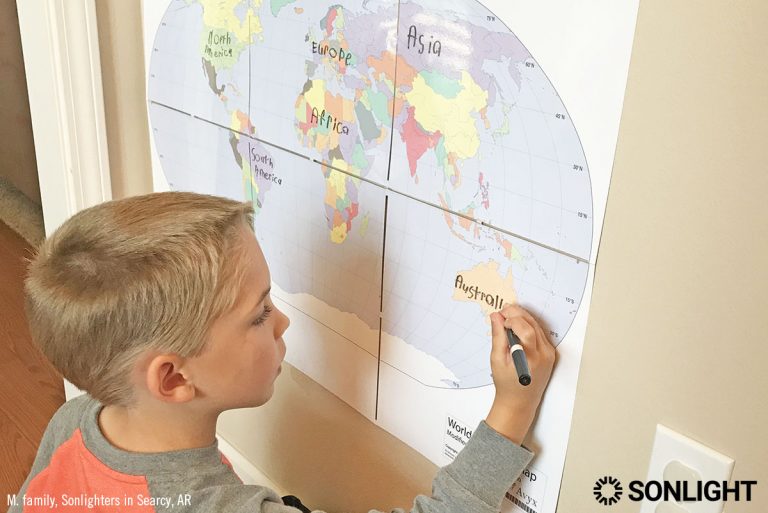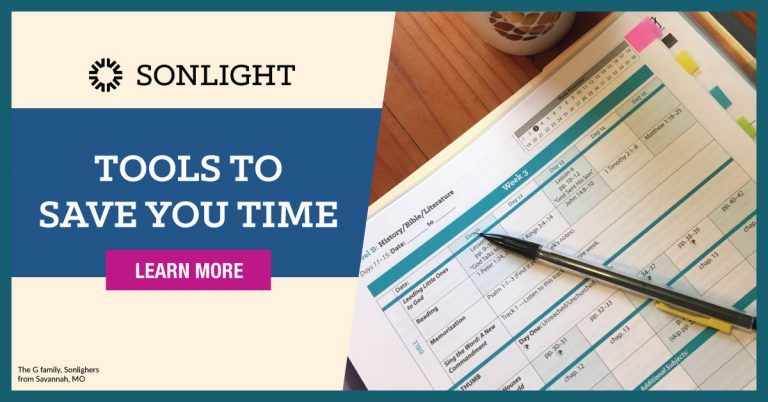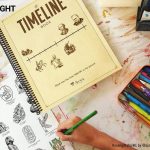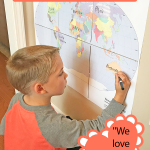
Sonlight’s complete curriculum packages come with everything you need to teach your child. But when budgets are tight, it’s easy to wonder if all those items are truly necessary or how they will be incorporated. You may be tempted to skimp on some of the things you consider extras.
Sonlight’s Markable Map is one product which might seem redundant, considering the laminated maps already included in the Instructor’s Guides. But, used together, mapwork boosts your child’s understanding of history, geography, and the world at large in a painless, easy-to-use way. Be sure to get the Markable Map!
Sonlight Maps
Sonlight has carefully designed maps to accompany the places you will be learning about in their books throughout the year. Newer Instructor’s Guides for History / Bible / Literature (HBL) A through HBL J have lovely laminated maps in the front, and high school level Instructor’s Guides and older guides have multiple paper maps instead. These maps are labeled, and the Instructor’s Guides clearly reference the areas of study.
Additionally, Sonlight offers a large, blank laminated map with wet-erase markers for your child to learn geography. This is the Markable Map. The wet-erase markers don’t wipe off as easily as typical dry-erase markers do, so they stand up to heavier daily use.
What Makes The Markable Map Different?
There are specific benefits our family found to using Sonlight’s Markable Map and laminated maps in the Instructor’s Guides that most other maps, atlases, and globes don't provide.
- First, and most importantly for our family, it’s blank. Totally blank. There are no states or countries written in. No words in the middle of the ocean. This might seem like a negative—until your child has to start looking for locations on it. Unlike other maps, my children have to focus to be able to use it. They can’t rely on looking for a capital A and hope they can find Argentina. They don’t become frustrated as easily when Mesopotamia doesn’t jump out at them. Suddenly, they have to look at the shape of the country and the surrounding areas, and find a place that matches. It takes more effort and concentration and thus, it is more likely to stick better. This is especially helpful in children who have learning disabilities that make memorization difficult, such as ADHD and dyslexia.
- Second, it’s specific to what we are learning about. With the Markable Map, we can highlight only the events that we are currently studying, leaving the other areas uncluttered and thereby less distracting. We can visualize why it took so long to get supplies through during the American Civil War because of how much land they had to cross with wagons and carts. My child can mark the battles of the Peloponnesian War, or the journey of the Mayflower as we follow them on their journey. Every time they look at the Markable Map, they remember writing those specific places in.
- Third, it’s double-sided. There’s a map of the US on one side, and the world on the other, making it easy to flip back between national and world events. While some families might not need this added bonus, having multiple maps to use, I found it beneficial to not have to pull out extra resources or find another map to show the areas we were talking about.
- Fourth, the scale lines up to the answer keys on the laminated maps in the Instructor’s Guides. We can easily find places that would otherwise be hard to locate and transfer them to the correct area without having to look up multiple resources or take a lot of extra time.
- Fifth, we can write anything on it, and then erase it. If we make a mistake, it’s easy to fix. Or, if we are done talking about an area of the world, we can clear up free space on our Markable Map. While some maps with pre-printed locations are compatible with wet-erase markers, they tend to look more and more cluttered as we add to them. The Markable Map, in contrast, can look exactly as clean or as cluttered as we want. I like to go through a few times a year with my children when it’s starting to look cluttered, and pick out which areas we are still discussing. We snap a photo in case we need to reference something or want to look back on it later. Then we erase it all, and start over; writing in the key areas from before.
- Finally, it is versatile in terms of storage. It folds up and slides easily under the sofa or onto the bookshelf. This means it’s easy to store away when company is coming, or pull out without taking a lot of extra effort when we need it. We have, in the past, also placed grommets in the corners and then hung the map from hooks to display it.
Most families only ever need one Markable Map, but with homeschooling multiple kids using multiple levels, I’ve found perks to using one map per program. Some families like to purchase two, so they can display each side (USA and world) and have both visible at the same time.
Added Benefits of Mapwork with the Markable Map
Sonlight’s carefully designed maps help create a visual reminder of what your child is learning. But, it doesn’t stop there. The mapwork crosses a variety of learning styles and adds that essential hands-on component many children need. This multi-sensory approach to learning between the books and maps helps create long-lasting memories of key places and events.
- Auditory: your child hears what you are reading to them. They listen to stories about people, places, and events, and how they all tie in together. They also internalize the pronunciations of those places.
- Interpersonal: you and your child talk about the story and answer questions.
- Visual: they observe what is happening in illustrations and the locations in the maps in the books. They see the places on the Markable Map. They follow events by drawing lines to show journeys and scrutinize patterns as events play out over the world. Sometimes, being able to view locations helps to further understand events.
- Kinesthetic: They experience the cool, smooth feel of the Markable Map. They feel the sensation of writing on the Markable Map with Markers. The larger sweeping arm motion to reach further-away locations, crossing the midline, and writing at angles to fit words into smaller places create connections in the brain. Labeling the Markable Map and outlining the shapes help to form a kinesthetic memory of the area.
- Reading, Writing, and Spelling: As children read the names and events on the maps, they are further familiarizing themselves with often unique or hard to spell names and places. They are seeing how the words are spelled and used together to form places like Santorini or Mesopotamia. They also need to write and spell the names of countries, towns, cities, etc. You can use the mapwork to aid in memorizing state and other location abbreviations. Writing these names on the map while hearing how they are pronounced leads them to further internalize world geography.
Tips for Using and Remembering to Do the Mapwork
At the beginning of every homeschool year, I fully intend to make use of every single aspect of my Sonlight curriculum. But as the year moves on, I find myself forgetting to do the mapwork activities or putting them off until there are so many that I feel behind. When I reframed my thinking and gave myself more visual reminders, I was able to remember the mapwork on a regular basis.
- With the Daily Work: I read through the Instructor's Guides a few weeks at a time and note where locations are mentioned and where mapwork is recommended. There are little symbols already there to remind me. To help them stand out, I can highlight, underline, or use a colored sticky flag. This extra visual reminder helps me do these activities when they were scheduled. I keep my Markable Map and Markers within easy reach on a shelf or the wall, depending on how much space our current temporary housing has.
- Regularly Scheduled Review: Sometimes, I don’t get to the guide on time, so around the beginning of each year (or semester, or week, or any given period of time), I go through my Instructor’s Guides and list the mapwork locations. At the end of that period, we review them all at once, discussing where we learned about each item and what happened there.
- Sporadic Review: As a busy parent with ADHD, I admit that sometimes, I just plain forget. At those times, I pull out a globe or atlas and have my children see how many places they can find that they read about as I page through the guide.
Activities and Games for the Markable Map
Sometimes, even fun or useful information can seem dry and boring. Here are some games and activities I have used sporadically to help liven things up and help my children look forward to learning about geography.
- Color Code: Sonlight sells 4 differently-colored wet erase markers with the Markable Map. We use this to color code our maps. Blue usually refers to bodies of water. Green to larger regions and countries. Red marks smaller countries or important areas; black is for cities and towns. You can choose how you would like your Markable Map to be color coordinated. We like to draw a little key in the bottom to remind us how we used each color.
- Musical Maps: Using the Geography Songs CD from HBL C, we practice daily until my children can point to the countries in time to the song. Each day they practice until they can get most of the countries correct while the music is playing. Some songs, such as Greenland, are pretty easy, but others are much more challenging.
- Map Timeline Figures: If you have an inexpensive map, an extra set of timeline figures can be pasted on to make your map even more visual.
- Make it Meaningful: Locate areas on your Markable Map where you’ve taken vacations, lived in the past, or want to visit someday. Our family also adds in locations relatives live or visit. If we remember, we ask them to send us a postcard from that area. If your child is into current events, they can map where certain pieces of news are happening or for children they are praying for around the world.
- Build Physical Maps: Occasionally, certain books will lend themselves nicely to making a map of your own, using drawings, bricks, or even play-dough. If you have a book that centers around a specific map, you can try having your child create their own version of the map to help cement it in their memory banks. We recently built a model of Wild Island from the book My Father’s Dragon, and made a map of the area around the boxcar out of Legos from the book The Boxcar Children, both from HBL A.
- Keep it Visible: When possible, we hang our Markable Map in a place where we can see it as we do our lessons. But when we are limited on wall space, or don’t want to mark up our walls (my husband vastly prefers the uncluttered look), we can fold it up and place it on the bookshelf right next to our Instructor’s Guides or with our history books. This helps to keep it in sight, making it harder to forget.
Mapping provides great learning opportunities for your children and aids in retention. Even if you can’t do all the mapping activities in your guide, these tips might help you to use them more often, make them more fun or interesting, and help you review. If you have any more ideas or suggestion, leave them in the comments for others to try.
See how Sonlight's detailed Instructor's Guides save you time and tell you precisely what to teach.









This is so helpful! Thank you!